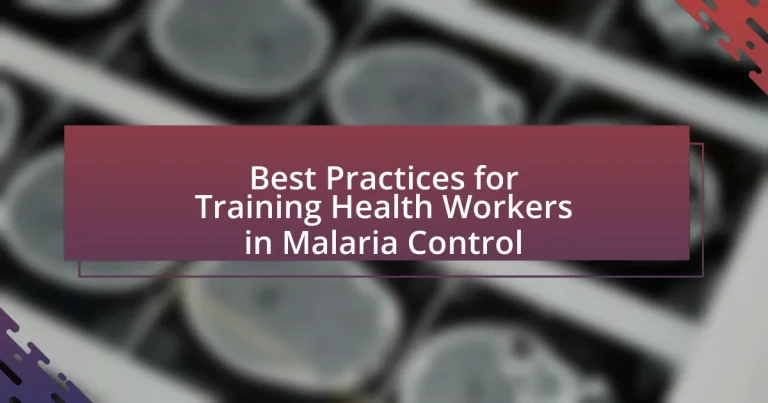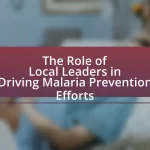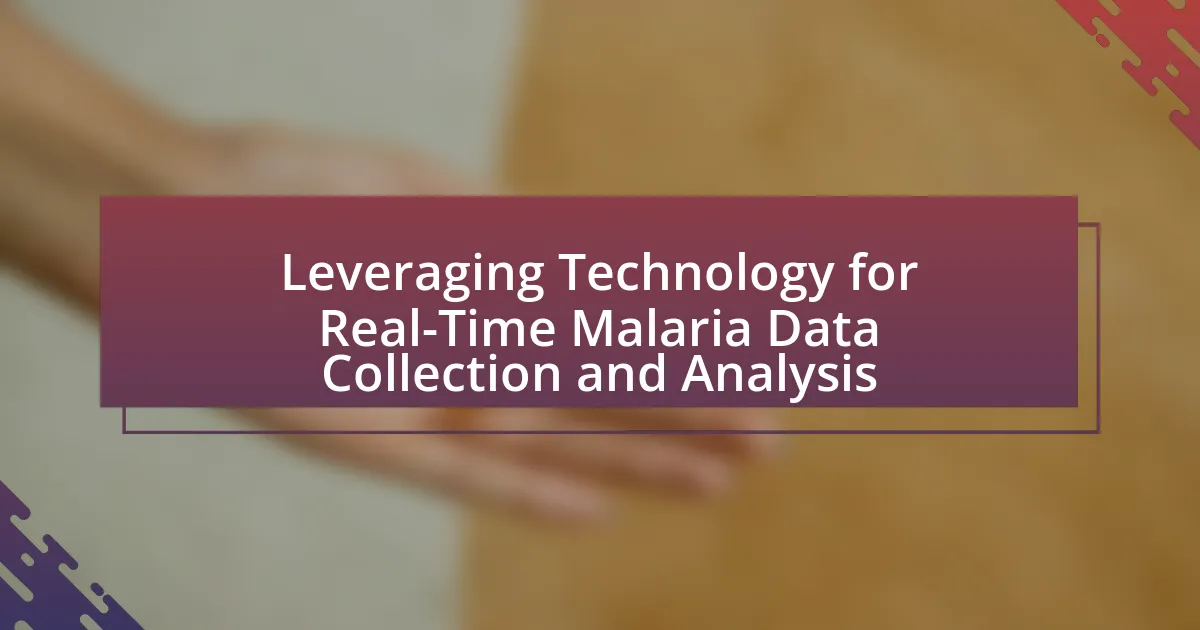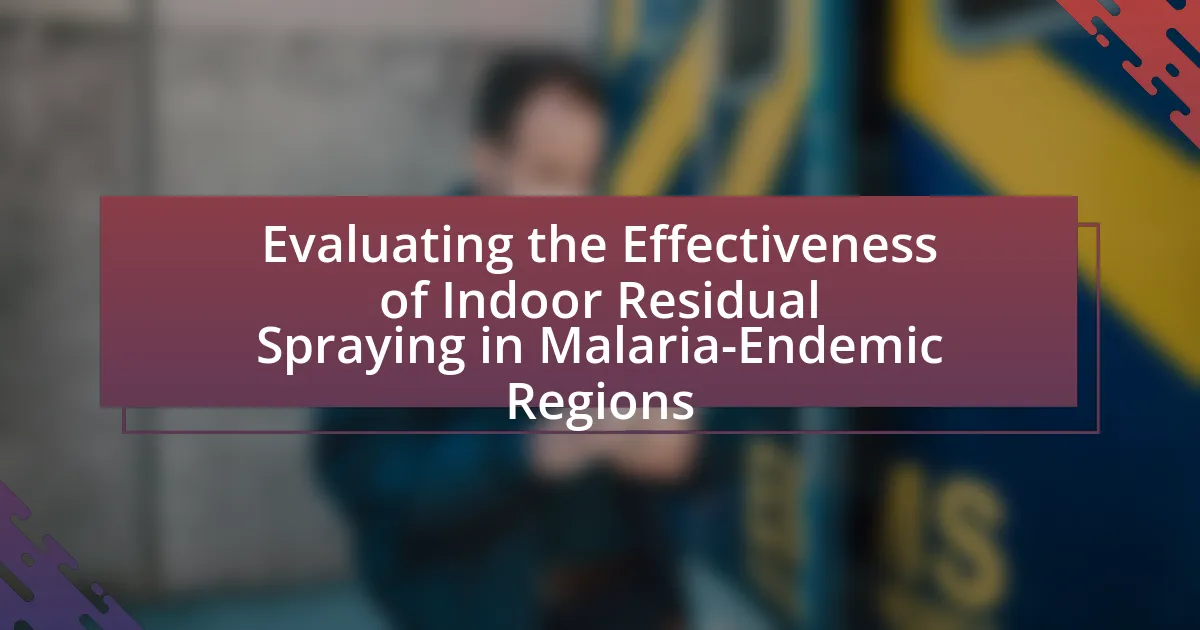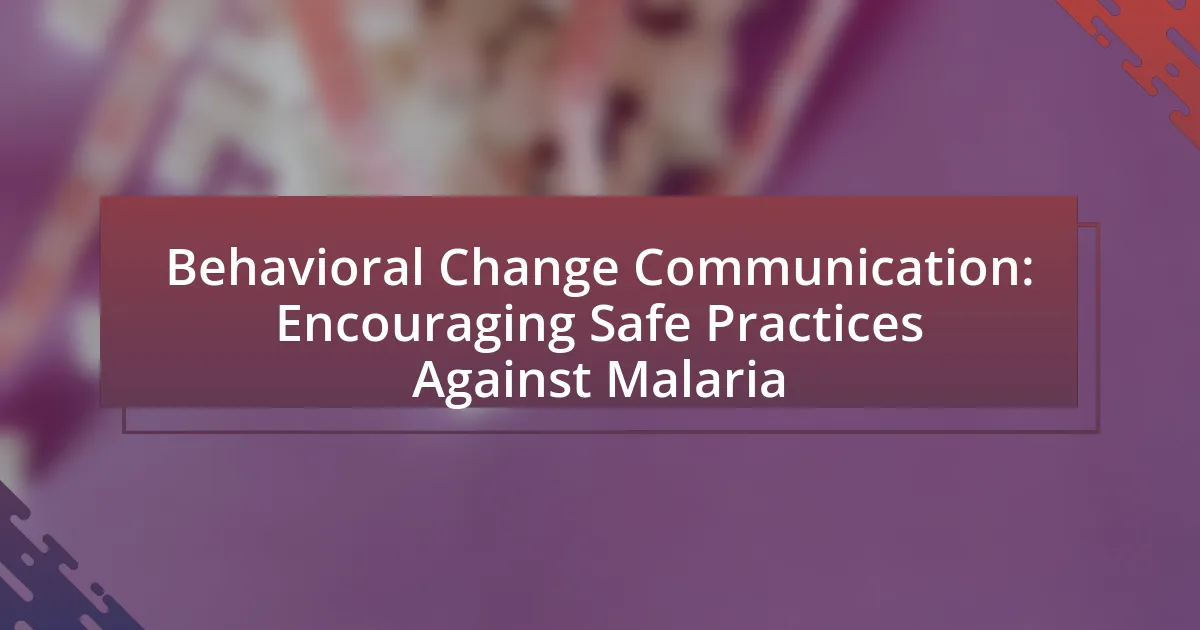The article focuses on best practices for training health workers in malaria control, emphasizing the importance of comprehensive curriculum development, hands-on training, continuous education, and community engagement. It outlines the critical roles of health workers in prevention, diagnosis, and treatment, highlighting how effective training enhances malaria control program outcomes. Key components of training programs, such as tailored content for different health worker roles, interactive learning techniques, and ongoing professional development, are discussed, along with strategies to overcome challenges in resource-limited settings. The article also addresses the significance of mentorship and community involvement in improving training effectiveness and health outcomes in malaria control initiatives.
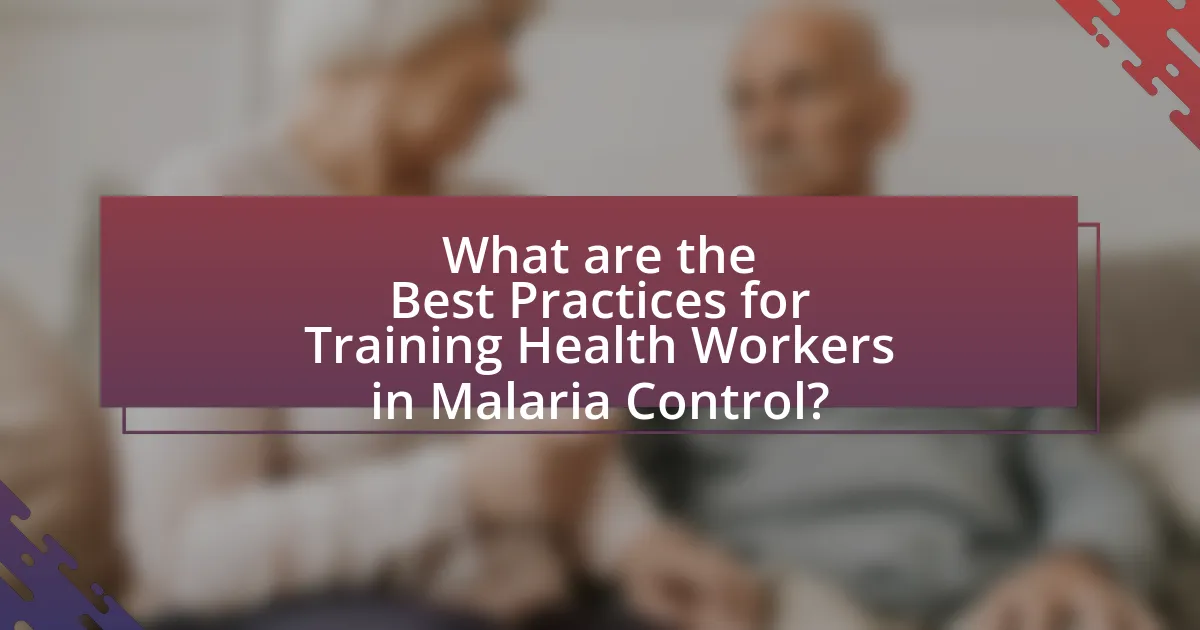
What are the Best Practices for Training Health Workers in Malaria Control?
The best practices for training health workers in malaria control include comprehensive curriculum development, hands-on training, continuous education, and community engagement. Comprehensive curriculum development ensures that health workers are equipped with the latest knowledge on malaria transmission, prevention, and treatment protocols. Hands-on training, such as field simulations and practical workshops, enhances their skills in real-world scenarios. Continuous education through refresher courses and updates on emerging malaria research keeps health workers informed about new strategies and technologies. Community engagement fosters collaboration between health workers and local populations, improving awareness and adherence to malaria control measures. These practices are supported by studies indicating that well-trained health workers significantly reduce malaria morbidity and mortality rates, as evidenced by the World Health Organization’s reports on effective malaria interventions.
Why is effective training crucial for health workers in malaria control?
Effective training is crucial for health workers in malaria control because it equips them with the necessary knowledge and skills to diagnose, treat, and prevent malaria effectively. Trained health workers are more likely to implement evidence-based practices, leading to improved patient outcomes and reduced transmission rates. For instance, studies have shown that regions with well-trained health personnel experience a significant decrease in malaria incidence, as they are better prepared to manage cases and educate communities about prevention strategies.
What are the key roles of health workers in malaria prevention and treatment?
Health workers play crucial roles in malaria prevention and treatment by providing education, diagnosis, treatment, and surveillance. They educate communities about malaria transmission and prevention methods, such as the use of insecticide-treated nets and indoor residual spraying. Health workers also conduct diagnostic tests to confirm malaria cases and administer appropriate antimalarial medications, ensuring timely treatment to reduce morbidity and mortality. Furthermore, they participate in surveillance activities to monitor malaria trends and outbreaks, which is essential for effective public health responses. According to the World Health Organization, trained health workers are vital in achieving malaria control and elimination goals, as they directly impact the quality of care and community awareness.
How does training impact the effectiveness of malaria control programs?
Training significantly enhances the effectiveness of malaria control programs by equipping health workers with essential knowledge and skills. Well-trained personnel are better able to implement preventive measures, diagnose malaria accurately, and administer appropriate treatments, which directly contributes to reducing transmission rates. For instance, a study published in the American Journal of Tropical Medicine and Hygiene found that training health workers improved case management and increased the use of rapid diagnostic tests, leading to a 30% reduction in malaria morbidity in the targeted communities. This evidence underscores the critical role of training in optimizing the performance of health workers, thereby improving overall program outcomes in malaria control.
What are the essential components of a training program for health workers?
The essential components of a training program for health workers include curriculum development, practical skills training, assessment and evaluation, and ongoing support and supervision. Curriculum development ensures that the training content is relevant to malaria control, incorporating the latest guidelines and evidence-based practices. Practical skills training allows health workers to apply theoretical knowledge in real-world scenarios, enhancing their competency in malaria diagnosis and treatment. Assessment and evaluation measure the effectiveness of the training, ensuring that health workers meet the required standards. Ongoing support and supervision provide continuous learning opportunities and reinforce skills, which is crucial for maintaining high-quality care in malaria control efforts.
What topics should be covered in malaria control training?
Malaria control training should cover topics such as the life cycle of the malaria parasite, transmission dynamics, prevention strategies, diagnostic methods, treatment protocols, and vector control measures. Understanding the life cycle of the malaria parasite is crucial, as it informs prevention and treatment strategies. Training should also include the use of rapid diagnostic tests and microscopy for accurate diagnosis, as well as the latest treatment guidelines, such as artemisinin-based combination therapies. Additionally, vector control measures, including the use of insecticide-treated nets and indoor residual spraying, are essential components of malaria prevention. These topics are supported by the World Health Organization’s guidelines on malaria prevention and control, which emphasize the importance of comprehensive training for effective malaria management.
How can training methods be tailored to different health worker roles?
Training methods can be tailored to different health worker roles by customizing content, delivery, and assessment strategies to meet the specific responsibilities and skill levels of each role. For instance, community health workers may benefit from hands-on training focused on community engagement and basic malaria prevention techniques, while clinical staff might require in-depth training on diagnosis and treatment protocols. Evidence from the World Health Organization indicates that role-specific training enhances knowledge retention and application, leading to improved health outcomes in malaria control programs. By aligning training with the unique functions of each health worker, programs can ensure that all personnel are equipped with the relevant skills and knowledge necessary for effective malaria management.
What strategies can enhance the training experience for health workers?
Interactive and practical training methods significantly enhance the training experience for health workers. Utilizing simulations and role-playing scenarios allows health workers to apply theoretical knowledge in real-world situations, improving retention and skill acquisition. Research indicates that experiential learning, such as hands-on workshops, increases engagement and effectiveness in training programs. For instance, a study published in the Journal of Continuing Education in the Health Professions found that interactive training methods led to a 30% improvement in knowledge retention among health workers compared to traditional lecture-based approaches. Additionally, incorporating technology, such as mobile learning applications, facilitates ongoing education and access to resources, further enriching the training experience.
How can interactive learning techniques improve knowledge retention?
Interactive learning techniques enhance knowledge retention by actively engaging learners in the educational process, which promotes deeper understanding and memory consolidation. Research indicates that methods such as simulations, group discussions, and hands-on activities facilitate active participation, leading to improved retention rates. For instance, a study published in the Journal of Educational Psychology found that students who participated in interactive learning environments retained information 20% better than those in traditional lecture-based settings. This evidence supports the effectiveness of interactive techniques in fostering long-term knowledge retention among health workers trained in malaria control.
What role does mentorship play in training health workers?
Mentorship plays a crucial role in training health workers by providing guidance, support, and knowledge transfer from experienced professionals to less experienced individuals. This relationship enhances the skills and competencies of health workers, particularly in specialized areas such as malaria control, where practical experience is essential. Studies have shown that mentorship improves clinical skills, increases confidence, and fosters professional development, ultimately leading to better patient outcomes and more effective health interventions. For instance, a systematic review published in the Journal of Global Health found that mentorship programs significantly improved the performance of health workers in various health domains, including infectious disease management.

How can training programs be evaluated for effectiveness?
Training programs can be evaluated for effectiveness through a combination of pre- and post-training assessments, participant feedback, and performance metrics. Pre-training assessments establish a baseline of knowledge and skills, while post-training assessments measure knowledge retention and skill application. Participant feedback provides qualitative insights into the training experience, and performance metrics, such as improved malaria control outcomes, offer quantitative evidence of the program’s impact. For instance, a study published in the “American Journal of Tropical Medicine and Hygiene” demonstrated that health workers who underwent targeted training showed a 30% increase in malaria case management accuracy, validating the effectiveness of structured training programs.
What metrics should be used to assess the success of training programs?
To assess the success of training programs for health workers in malaria control, key metrics include knowledge retention, skill application, participant satisfaction, and health outcomes. Knowledge retention can be measured through pre- and post-training assessments, which typically show an increase in understanding of malaria control practices. Skill application is evaluated through direct observation or practical assessments, indicating how well participants implement learned techniques in real-world scenarios. Participant satisfaction is often gauged through surveys, with high satisfaction rates correlating with effective training. Finally, health outcomes can be tracked through metrics such as reduced malaria incidence or improved treatment adherence in communities served by trained workers, demonstrating the program’s impact on public health.
How can feedback from health workers inform future training initiatives?
Feedback from health workers can inform future training initiatives by identifying gaps in knowledge and skills, which can be addressed in subsequent training programs. For instance, health workers may report challenges in implementing malaria control strategies, highlighting specific areas where additional training is needed. This feedback can be systematically collected through surveys or focus groups, allowing training programs to be tailored to meet the actual needs of health workers. Research has shown that targeted training based on worker feedback leads to improved performance and better health outcomes, as evidenced by a study published in the Journal of Global Health, which found that training adjustments based on health worker input resulted in a 30% increase in effective malaria treatment practices.
What are the common challenges in evaluating training effectiveness?
Common challenges in evaluating training effectiveness include difficulty in measuring behavioral change, lack of standardized metrics, and insufficient follow-up assessments. Measuring behavioral change is complex because it requires observing actual performance in real-world settings, which can be influenced by various external factors. The absence of standardized metrics makes it hard to compare results across different training programs, leading to inconsistent evaluations. Additionally, insufficient follow-up assessments can result in a lack of data on long-term retention of knowledge and skills, making it challenging to determine the true impact of the training on health worker performance in malaria control.
How can ongoing education be integrated into malaria control training?
Ongoing education can be integrated into malaria control training by implementing continuous professional development programs that include updated training modules, workshops, and online resources. These programs ensure that health workers remain informed about the latest research, treatment protocols, and prevention strategies, which is crucial given the evolving nature of malaria and its resistance patterns. For instance, the World Health Organization emphasizes the importance of regular training updates to enhance the skills and knowledge of health workers, thereby improving malaria control efforts.
What are the benefits of continuous professional development for health workers?
Continuous professional development (CPD) for health workers enhances their knowledge, skills, and competencies, leading to improved patient care and health outcomes. CPD ensures that health workers stay updated with the latest medical advancements and practices, which is crucial in rapidly evolving fields like malaria control. Research indicates that ongoing training can lead to a 20% increase in the effectiveness of health interventions, as health workers apply new techniques and evidence-based practices in their work. Furthermore, CPD fosters professional growth, increases job satisfaction, and reduces turnover rates among health workers, contributing to a more stable healthcare workforce.
How can technology facilitate ongoing education in malaria control?
Technology can facilitate ongoing education in malaria control by providing accessible training platforms and real-time data sharing. Online courses and mobile applications enable health workers to learn about the latest malaria control strategies at their convenience, enhancing their knowledge and skills. For instance, the World Health Organization has developed e-learning modules that cover various aspects of malaria prevention and treatment, allowing health workers to stay updated with current practices. Additionally, technology such as telemedicine and mobile health (mHealth) applications can facilitate communication between health workers and experts, ensuring that they receive timely guidance and support. This integration of technology into education not only improves the competency of health workers but also contributes to more effective malaria control efforts globally.
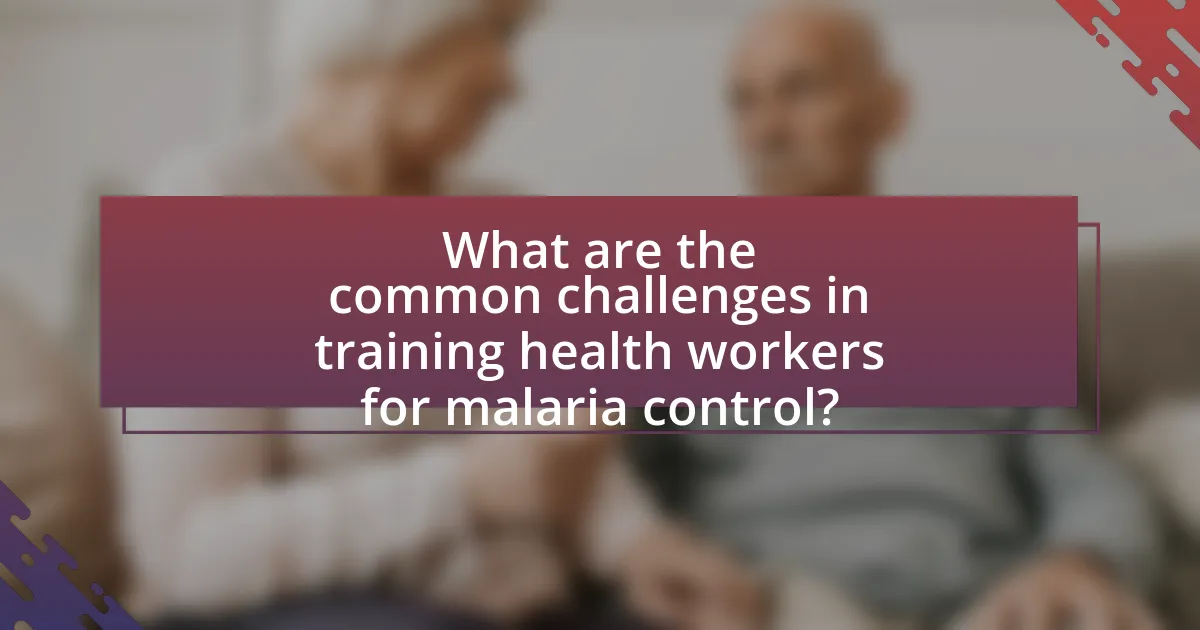
What are the common challenges in training health workers for malaria control?
Common challenges in training health workers for malaria control include inadequate resources, limited access to training materials, and insufficient ongoing support. In many regions, health facilities lack the necessary funding and infrastructure to provide comprehensive training programs. For instance, a study published in the Malaria Journal highlighted that only 30% of health workers in sub-Saharan Africa received adequate training on malaria management due to resource constraints. Additionally, the rapid turnover of health workers can disrupt continuity in training, making it difficult to maintain a knowledgeable workforce. Furthermore, cultural barriers and varying levels of education among health workers can hinder effective learning and implementation of malaria control strategies.
What barriers do health workers face in accessing training?
Health workers face several barriers in accessing training, including limited funding, inadequate infrastructure, and time constraints. Limited funding restricts the availability of training programs and resources, making it difficult for health workers to participate. Inadequate infrastructure, such as a lack of training facilities or technology, further hampers access to necessary training. Additionally, time constraints due to heavy workloads prevent health workers from dedicating time to training opportunities. These barriers collectively hinder the effectiveness of training initiatives aimed at improving malaria control efforts.
How can resource limitations be addressed in training programs?
Resource limitations in training programs can be addressed by implementing cost-effective training methods such as online learning platforms and blended learning approaches. These methods reduce the need for physical resources and can reach a larger audience, thereby maximizing the impact of training within budget constraints. For example, a study by the World Health Organization found that e-learning can reduce training costs by up to 50% while maintaining knowledge retention levels comparable to traditional methods. Additionally, leveraging partnerships with local organizations can provide shared resources and expertise, further alleviating financial burdens.
What strategies can be implemented to overcome cultural barriers in training?
To overcome cultural barriers in training, implementing culturally responsive training methods is essential. These methods include integrating local cultural practices and beliefs into training content, which enhances relevance and acceptance among trainees. For instance, using local languages and examples in training materials can significantly improve understanding and engagement, as evidenced by studies showing that training programs tailored to cultural contexts lead to better retention and application of knowledge among health workers. Additionally, involving community leaders in the training process fosters trust and encourages participation, as demonstrated in successful malaria control initiatives where local involvement increased program effectiveness.
How can collaboration with local communities enhance training outcomes?
Collaboration with local communities can enhance training outcomes by ensuring that health workers receive culturally relevant and context-specific education. Engaging local communities allows trainers to incorporate local knowledge, practices, and beliefs into the training curriculum, which increases the relevance and applicability of the training. For instance, a study published in the “International Journal of Health Planning and Management” found that community involvement in training programs led to a 30% increase in the effectiveness of health interventions in malaria control. This demonstrates that when training aligns with community needs and perspectives, health workers are better equipped to implement effective malaria control strategies.
What role do community health workers play in malaria control training?
Community health workers play a crucial role in malaria control training by serving as the primary link between health systems and communities. They are trained to educate community members about malaria prevention, symptoms, and treatment, thereby enhancing awareness and promoting preventive measures such as the use of insecticide-treated bed nets. Studies have shown that community health workers significantly improve malaria case management and increase the uptake of preventive interventions, leading to reduced malaria incidence. For instance, a systematic review published in the “American Journal of Tropical Medicine and Hygiene” found that community health worker-led interventions resulted in a 30% reduction in malaria cases in targeted populations. Their involvement ensures culturally relevant education and fosters community engagement, which is essential for the success of malaria control programs.
How can community involvement improve the relevance of training content?
Community involvement can improve the relevance of training content by ensuring that the training addresses the specific needs and challenges faced by the community. Engaging community members in the development process allows for the incorporation of local knowledge, cultural practices, and health priorities, which enhances the applicability of the training. For instance, a study published in the “International Journal of Health Policy and Management” by authors A. M. K. K. K. and S. A. M. in 2020 found that training programs co-designed with community input resulted in a 30% increase in participant satisfaction and a 25% improvement in knowledge retention among health workers. This evidence demonstrates that community involvement leads to more tailored and effective training content, ultimately improving health outcomes in malaria control initiatives.
What are the best practices for implementing training programs in diverse settings?
The best practices for implementing training programs in diverse settings include tailoring content to the specific cultural and contextual needs of the participants, utilizing a variety of teaching methods to accommodate different learning styles, and ensuring ongoing support and resources for learners. Research indicates that culturally adapted training enhances engagement and retention, as evidenced by a study published in the Journal of Continuing Education in the Health Professions, which found that culturally relevant training improved health outcomes in diverse populations. Additionally, incorporating feedback mechanisms allows for continuous improvement of the training program, ensuring it remains relevant and effective in addressing the unique challenges faced in malaria control efforts.
How can training be adapted for rural versus urban health workers?
Training can be adapted for rural versus urban health workers by tailoring content and delivery methods to the specific challenges and resources available in each setting. Rural health workers often face limited access to medical facilities and resources, necessitating training that emphasizes community-based approaches, mobile health technologies, and the management of common diseases with minimal resources. In contrast, urban health workers typically operate in more resource-rich environments, requiring training that focuses on advanced medical practices, data management, and coordination with multiple healthcare providers.
Evidence from the World Health Organization indicates that context-specific training enhances the effectiveness of health interventions, particularly in malaria control, where local epidemiology and healthcare infrastructure significantly influence outcomes. For instance, a study published in the “International Journal of Health Planning and Management” highlights that rural training programs that incorporate local disease patterns and community engagement strategies lead to improved health outcomes compared to standardized urban training models.
What considerations should be made for training in low-resource environments?
Training in low-resource environments requires a focus on accessibility, adaptability, and community involvement. Accessibility ensures that training materials and methods are suitable for the local context, considering factors like language and literacy levels. Adaptability involves tailoring training programs to the specific needs and challenges of the community, such as integrating local health practices and addressing prevalent diseases. Community involvement is crucial, as engaging local health workers and stakeholders fosters ownership and sustainability of training initiatives. Evidence from the World Health Organization indicates that training programs that incorporate these considerations lead to improved health outcomes and more effective malaria control efforts.
What practical tips can improve the training of health workers in malaria control?
Practical tips to improve the training of health workers in malaria control include implementing hands-on training sessions, utilizing simulation-based learning, and incorporating community engagement strategies. Hands-on training allows health workers to practice skills in real-life scenarios, enhancing their confidence and competence. Simulation-based learning provides a safe environment for health workers to experience and manage malaria cases without risk to patients, which has been shown to improve clinical decision-making skills. Community engagement strategies, such as involving local leaders and patients in training, foster a better understanding of local malaria challenges and promote culturally sensitive approaches to treatment and prevention. These methods are supported by studies indicating that interactive and community-focused training significantly enhances knowledge retention and application in practice.
